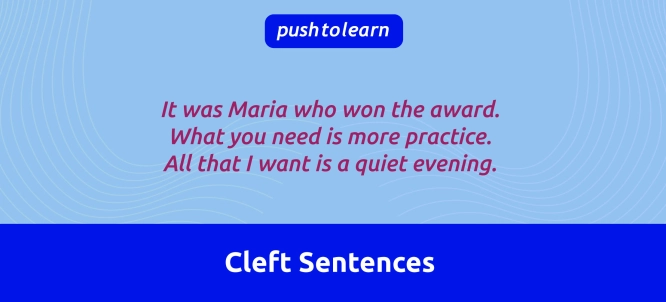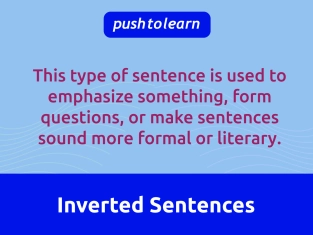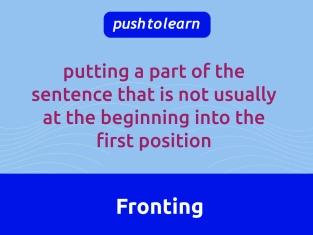by PushtoLearn
Cleft Sentences
Table of Contents
Cleft Sentences - Exercise
This exercise focuses on Cleft Sentences
Cleft sentences often begin with phrases like It is/was, What, The thing that, or All that and can bring focus to the key part of the sentence, making it stand out more than in a typical sentence structure.
Types of Cleft Sentences
-
It-Cleft Sentences
-
Wh-Cleft (What-Cleft) Sentences
-
All-Cleft Sentences
-
Other Cleft Forms
It-Cleft Sentences
Structure:
“It + be + emphasized information + relative clause (that/who/when)”
This form places emphasis on a specific part of the sentence, such as the subject or object.
Examples:
-
Basic Sentence: "Maria won the award."
-
It-Cleft for Emphasis on Subject: "It was Maria who won the award."
-
It-Cleft for Emphasis on Object: "It was the award that Maria won."
Use:
Use It-cleft sentences to highlight specific information or to clarify focus when there are several possible interpretations.

Wh-Cleft (What-Cleft) Sentences
Structure:
“What + clause + be + emphasized information”
Wh-cleft sentences (commonly called What-cleft sentences) are used to emphasize what happened, what was done, or other specific details.
Examples:
-
Basic Sentence: "She loves painting."
-
Wh-Cleft: "What she loves is painting."
-
Basic Sentence: "You need more practice."
-
Wh-Cleft: "What you need is more practice."
Use:
Wh-cleft sentences can emphasize the action or focus of the sentence, often making it sound more dramatic or clear.
All-Cleft Sentences
Structure:
“All that + clause + be + emphasized information”
All-cleft sentences are used when focusing on a singular thing that represents the most important information in the sentence.
Examples:
-
Basic Sentence: "I want a quiet evening."
-
All-Cleft: "All that I want is a quiet evening."
-
Basic Sentence: "They needed was someone to listen."
-
All-Cleft: "All they needed was someone to listen."
Use:
Use all-cleft sentences to emphasize something essential, particularly in expressing desires, needs, or expectations.
Other Cleft Forms
There are additional cleft constructions used to highlight time, place, or reason, though they are less common.
-
Time: “It was in 2020 that they moved to the new office.”
-
Place: “It was in New York where they first met.”
-
Reason: “The reason why she left is that she found a new job.”
Advanced Tips for Usage
-
Clarifying Complex Sentences
-
Cleft sentences can break down complex ideas by organizing information into a structure that makes the key idea clear.
-
Example: "The person who suggested this was Anna." → "It was Anna who suggested this."
-
Avoiding Ambiguity
-
Cleft sentences help to remove ambiguity by focusing attention on a specific element, making sure readers or listeners understand the intended meaning.
-
Example: “I only need a new laptop.” vs. “What I need is only a new laptop.”
-
Emphasizing Key Information
-
Cleft sentences are particularly useful in spoken English, where we can use tone and emphasis for focus. Cleft structures let you add the same kind of emphasis in written English.
-
Example: "It was because of the storm that we canceled the event."
Common Mistakes
-
Overusing Cleft Sentences
-
Overuse of cleft sentences can make writing sound repetitive and unnatural. Use them selectively to maintain emphasis without overwhelming the reader.
-
Overuse: “It was John who called. It was Sarah who answered. It was later when they met.”
-
Incorrect Placement of Emphasis
-
Be careful to place the focus on the correct part of the sentence. Placing emphasis on the wrong element can lead to confusion.
-
Correct: “It was the weather that caused the delay.”
-
Incorrect: “It was caused by the weather that the delay happened.”
-
Using Cleft Sentences in Very Formal Writing
Cleft sentences are useful in speech and informal writing, but they may seem out of place in highly formal writing, where direct sentences are often preferred. There are also other ways to emphasize parts of a sentence. It can be fronting or inverted sentences.
FAQ
When should I use an it-cleft sentence instead of a wh-cleft sentence?
Use an it-cleft sentence when you want to emphasize a specific noun or pronoun (subject or object) directly, and use a wh-cleft sentence when you want to highlight the action or main idea of the sentence.
Example: “It was Maria who finished the project” (it-cleft) vs. “What she finished was the project” (wh-cleft).
Can I use cleft sentences in both spoken and written English?
Yes, cleft sentences work in both spoken and written English. In speech, they help add emphasis, and in writing, they clarify complex ideas or draw attention to a particular element.
How do I form a cleft sentence to emphasize time?
To emphasize time, use “It was + time + that…”
Example: “It was yesterday that they announced the changes.”
Are cleft sentences used in formal writing?
Cleft sentences can appear in formal writing but are used sparingly. In more formal contexts, straightforward sentences are often preferred for conciseness and clarity.
What’s the main purpose of cleft sentences?
Cleft sentences help organize a sentence to highlight or emphasize particular information, making it stand out. This is useful when you want to make sure readers or listeners focus on one key part of a sentence.

